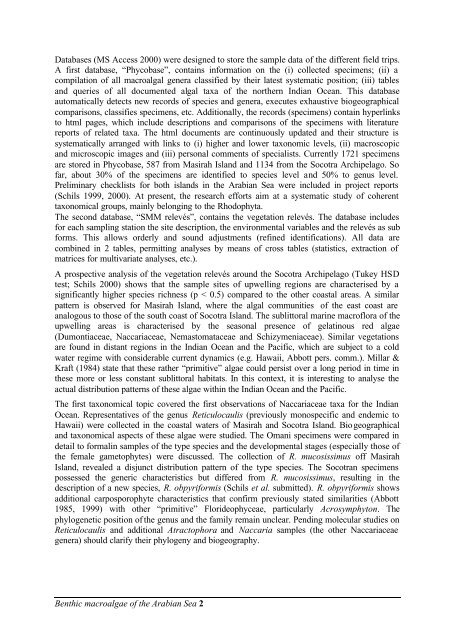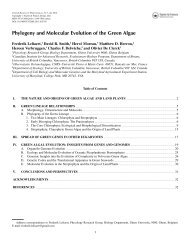Benthic macroalgae of the Arabian Sea 1 Benthic macroalgae of the ...
Benthic macroalgae of the Arabian Sea 1 Benthic macroalgae of the ...
Benthic macroalgae of the Arabian Sea 1 Benthic macroalgae of the ...
You also want an ePaper? Increase the reach of your titles
YUMPU automatically turns print PDFs into web optimized ePapers that Google loves.
Databases (MS Access 2000) were designed to store <strong>the</strong> sample data <strong>of</strong> <strong>the</strong> different field trips.A first database, “Phycobase”, contains information on <strong>the</strong> (i) collected specimens; (ii) acompilation <strong>of</strong> all macroalgal genera classified by <strong>the</strong>ir latest systematic position; (iii) tablesand queries <strong>of</strong> all documented algal taxa <strong>of</strong> <strong>the</strong> nor<strong>the</strong>rn Indian Ocean. This databaseautomatically detects new records <strong>of</strong> species and genera, executes exhaustive biogeographicalcomparisons, classifies specimens, etc. Additionally, <strong>the</strong> records (specimens) contain hyperlinksto html pages, which include descriptions and comparisons <strong>of</strong> <strong>the</strong> specimens with literaturereports <strong>of</strong> related taxa. The html documents are continuously updated and <strong>the</strong>ir structure issystematically arranged with links to (i) higher and lower taxonomic levels, (ii) macroscopicand microscopic images and (iii) personal comments <strong>of</strong> specialists. Currently 1721 specimensare stored in Phycobase, 587 from Masirah Island and 1134 from <strong>the</strong> Socotra Archipelago. S<strong>of</strong>ar, about 30% <strong>of</strong> <strong>the</strong> specimens are identified to species level and 50% to genus level.Preliminary checklists for both islands in <strong>the</strong> <strong>Arabian</strong> <strong>Sea</strong> were included in project reports(Schils 1999, 2000). At present, <strong>the</strong> research efforts aim at a systematic study <strong>of</strong> coherenttaxonomical groups, mainly belonging to <strong>the</strong> Rhodophyta.The second database, “SMM relevés”, contains <strong>the</strong> vegetation relevés. The database includesfor each sampling station <strong>the</strong> site description, <strong>the</strong> environmental variables and <strong>the</strong> relevés as subforms. This allows orderly and sound adjustments (refined identifications). All data arecombined in 2 tables, permitting analyses by means <strong>of</strong> cross tables (statistics, extraction <strong>of</strong>matrices for multivariate analyses, etc.).A prospective analysis <strong>of</strong> <strong>the</strong> vegetation relevés around <strong>the</strong> Socotra Archipelago (Tukey HSDtest; Schils 2000) shows that <strong>the</strong> sample sites <strong>of</strong> upwelling regions are characterised by asignificantly higher species richness (p < 0.5) compared to <strong>the</strong> o<strong>the</strong>r coastal areas. A similarpattern is observed for Masirah Island, where <strong>the</strong> algal communities <strong>of</strong> <strong>the</strong> east coast areanalogous to those <strong>of</strong> <strong>the</strong> south coast <strong>of</strong> Socotra Island. The sublittoral marine macr<strong>of</strong>lora <strong>of</strong> <strong>the</strong>upwelling areas is characterised by <strong>the</strong> seasonal presence <strong>of</strong> gelatinous red algae(Dumontiaceae, Naccariaceae, Nemastomataceae and Schizymeniaceae). Similar vegetationsare found in distant regions in <strong>the</strong> Indian Ocean and <strong>the</strong> Pacific, which are subject to a coldwater regime with considerable current dynamics (e.g. Hawaii, Abbott pers. comm.). Millar &Kraft (1984) state that <strong>the</strong>se ra<strong>the</strong>r “primitive” algae could persist over a long period in time in<strong>the</strong>se more or less constant sublittoral habitats. In this context, it is interesting to analyse <strong>the</strong>actual distribution patterns <strong>of</strong> <strong>the</strong>se algae within <strong>the</strong> Indian Ocean and <strong>the</strong> Pacific.The first taxonomical topic covered <strong>the</strong> first observations <strong>of</strong> Naccariaceae taxa for <strong>the</strong> IndianOcean. Representatives <strong>of</strong> <strong>the</strong> genus Reticulocaulis (previously monospecific and endemic toHawaii) were collected in <strong>the</strong> coastal waters <strong>of</strong> Masirah and Socotra Island. Biogeographicaland taxonomical aspects <strong>of</strong> <strong>the</strong>se algae were studied. The Omani specimens were compared indetail to formalin samples <strong>of</strong> <strong>the</strong> type species and <strong>the</strong> developmental stages (especially those <strong>of</strong><strong>the</strong> female gametophytes) were discussed. The collection <strong>of</strong> R. mucosissimus <strong>of</strong>f MasirahIsland, revealed a disjunct distribution pattern <strong>of</strong> <strong>the</strong> type species. The Socotran specimenspossessed <strong>the</strong> generic characteristics but differed from R. mucosissimus, resulting in <strong>the</strong>description <strong>of</strong> a new species, R. obpyriformis (Schils et al. submitted). R. obpyriformis showsadditional carposporophyte characteristics that confirm previously stated similarities (Abbott1985, 1999) with o<strong>the</strong>r “primitive” Florideophyceae, particularly Acrosymphyton. Thephylogenetic position <strong>of</strong> <strong>the</strong> genus and <strong>the</strong> family remain unclear. Pending molecular studies onReticulocaulis and additional Atractophora and Naccaria samples (<strong>the</strong> o<strong>the</strong>r Naccariaceaegenera) should clarify <strong>the</strong>ir phylogeny and biogeography.<strong>Benthic</strong> <strong>macroalgae</strong> <strong>of</strong> <strong>the</strong> <strong>Arabian</strong> <strong>Sea</strong> 2
















